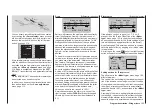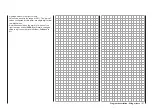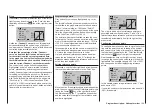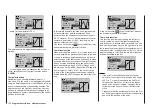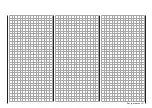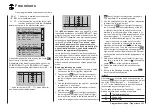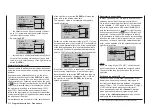
195
Program description - Helicopter mixer
Roll
Tail and Nick
Tail
0%
0%
SEL
0%
0%
0%
normal
Roll
Roll
Throttle
Tail
Nick
Nick
Throttle
Tail
Gyro suppress
Increasing pitch is not the only change that requires a
corresponding torque compensation via the tail rotor:
major cyclic control movements also require this, e. g.
if the swashplate is tilted in any direction. Here, too,
the program of the transmitters
mc-16
HoTT and
mc-20
HoTT lets you configure settings for both
types of tilt movement (roll and pitch-axis) separately.
For advanced aerobatics in particular, which involve
very large control deflections in the pitch-axis con-
trols, e. g. the “Bo-turn” (vertical pull-up followed by
tipping over around the pitch-axis) and tight loops,
the uncompensated torque present in these flights
causes the model to turn to a greater or lesser de-
gree around the yaw axis. This spoils the appearance
of the maneuver.
These two mixers permit static torque compensation
to be activated by the swashplate tilting in any direc-
tion. The mixers work by always increasing tail rotor
thrust, starting from the center point of the roll and
pitch-axis sticks, i. e. they always generate a tail ro-
tor deflection in the same direction regardless of the
direction of the command.
The mixer value can be varied within the range 0 to
+100 %.
The mixer direction is determined automatically by
your definition of the direction of main rotor rotation
on the »Helicopter type« menu, page 108.
In the auto-rotation flight phase this mixer is auto-
matically switched off.
Depending on the transmitter control’s position, the
gyro gain at full travel on the tail rotor stick is:
“current control position
minus
gyro suppression value”.
Accordingly, if the transmitter control is at the neutral
point, and gyro suppression is set to 100 %, the gyro
gain is reduced to zero as the tail rotor deflection in-
creases. For values between 100 % and the maximum
value of 199 %, the gyro can be fully suppressed – de-
pending on the transmitter control position – well
before full deflection of the tail rotor; see the diagram
on the next page.
For the Graupner/JR gyro NEJ-120 BB, order no.
3277, both the upper and the lower values are set via
rotary controls: control 1 sets the minimum gyro gain
at the bottom position of the slider; control 2 sets the
maximum gain at the top end-point of the slider; the
transition between these two values occurs roughly in
the middle of the slider travel.
In contrast, the PIEZO 900, PIEZO 2000 and PIE-
ZO 3000 gyro systems feature proportional, infinitely
variable adjustment of gyro gain; see below for typical
diagrams.
As an example, the option to configure flight phase-
specific – and static – gyro gain gives you the opportu-
nity to exploit maximum stabilization for normal, slow
flying, but to reduce gyro gain for fast circuits and
aerobatics.
Samples of various gyro settings and configuration
notes
• Linear gyro suppression: 0 % to 199 %.
With the tail rotor stick in the center position,
the resulting gyro effect is set using the select-
ed transmitter control. Using a proportional rotary
control or slider, the effect is infinitely variable be-
tween zero (“min”) and maximum (“max”), provid-
ed transmitter control travel is not restricted. With
Gyro suppress
0%
0%
SEL
0%
0°
normal
0%
Nick
Nick
Throttle
Tail
Swash rotation
Gyro suppress
Gyro gain
Important: in normal situations, this function
should not be used if your model is fitted with a
modern gyro system. In this context, ensure that
you comply with the instructions on adjusting
your gyro: if not, you risk making adjustments
that render your helicopter impossible to fly. This
menu has nonetheless been retained in order to cater
to a full range of requirements and flying habits.
With this option, the effect of the gyro sensor (“gyro”)
can be varied according to the tail rotor stick position;
this assumes the use of a gyro system whose gyro
gain can be controlled from the transmitter via an
auxiliary channel. This channel will be channel 7 for
Graupner remote control systems. The gyro suppres-
sion function reduces gyro gain in a linear progres-
sion as the pilot increases the tail rotor deflection.
Without gyro suppression – i. e. when set to 0 % – the
gyro effect is constant, regardless of the stick posi-
tion.
With a transmitter control assigned on the “Gyro” line
on the »Control adjust« menu, page 126, e. g. one
of the proportional sliders mounted in the middle con-
sole; as applicable, also made flight-phase depend-
ent and/or with infinitely variable gyro effect between
minimum and maximum. In this case, gyro gain is
maximum at full deflection of the slider, and zero at
the opposite end-point.
Of course, the software lets you limit the gyro gain
range on both sides by altering the transmitter con-
trol travel.
Содержание HoTT MC-16 Series
Страница 1: ...Programming Manual mc 16 mc 20 HoTT 1 en mc 16 mc 20...
Страница 27: ...27 For your notes...
Страница 53: ...53 For your notes...
Страница 61: ...61 For your notes...
Страница 65: ...65 For your notes...
Страница 71: ...71 For your notes...
Страница 103: ...103 For your notes...
Страница 107: ...107 For your notes...
Страница 111: ...111 For your notes...
Страница 133: ...133 Program description Dual Rate Expo Winged models Set the Expo values as necessary in the same man ner...
Страница 137: ...137 Program description Dual Rate Expo Helicopter models Set the Expo values as necessary in the same man ner...
Страница 155: ...155 For your notes...
Страница 165: ...165 For your notes...
Страница 201: ...201 For your notes...
Страница 229: ...229 For your notes...
Страница 231: ...231 For your notes...
Страница 261: ...261 For your notes...
Страница 265: ...265 For your notes...
Страница 301: ...301 For your notes...
Страница 327: ...327 For your notes...
Страница 328: ...328 For your notes...





